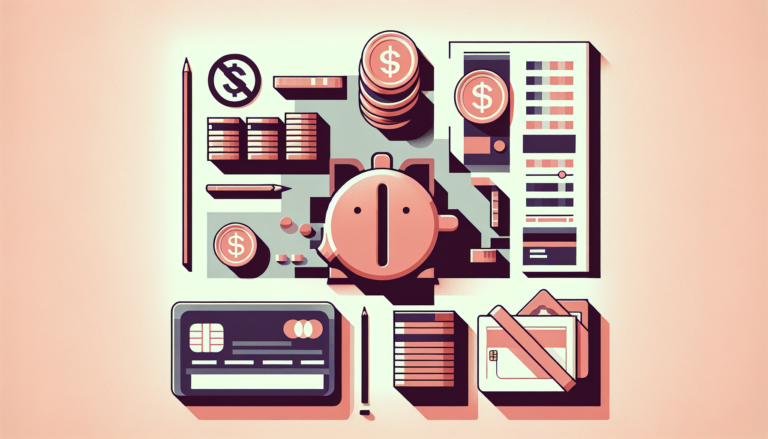Thrifty Living Made Easy: Money-Saving Hacks for Everyday Expenses
Optimizing Logistics Costs
Wanna save some dough and make your wallet smile? Let’s talk logistics. Getting those logistics costs under control is like finding change under the couch cushions! Two tried-and-true methods to make this happen? Streamline your inventory and consolidate those shipments.
Streamlining Inventory Levels
First up: Inventory. Keeping it lean means profits stay green. By just-right-sizing your inventory, you dodge high storage fees, kiss overstock goodbye, and say see ya later to waste. Nail your inventory flow, and you’ll notice products gliding through the warehouse like a laptop on Black Friday, all while slashing those pesky carrying costs.
Implementing Shipping Consolidation
Next on the money-saving train is shipping consolidation. Think of it like carpooling for packages. Combining shipments makes transportation a bargain deal. Got a big shipment? Full-load shipping (FTL) might be your pal. Or bundle up deliveries for multiple clients in one run—that’s smart delivery at a discount, cha-ching!
| Shipment Type | Cost Savings |
|---|---|
| Individual Shipments | $100 each |
| Consolidated Shipping | $80 per shipment (bundle!) |
Jump on the shipping consolidation wagon, and you’ll be running a tight ship, upping the efficiency game—and your bottom line will thank you for it.
Optimizing logistics is more than just cutting costs—it’s about running a slicker operation. These strategies sync up with smart budgeting tips and can even be a game-changer for folks looking to shrink those monthly bills and cut household costs like a pro. Let’s make those savings sing!
Efficient Utility Consumption
Cutting back on utilities ain’t just good for Mother Earth, it’s also kind to your wallet. Here’s how you can keep a lid on those electricity and water bills:
Lowering Electricity Usage
Kicking your electric bill to the curb starts with little habits. Flicking off lights, swapping in LED bulbs, and unplugging stuff can cut that monthly bill by a hefty chunk, up to 25%, says InCharge.
Simple gadget alert: A smart energy monitor can be your best pal. It tells you where the juice is flowing so you can zap usage and pocket some bucks. Knowledge is power—and it saves power too!
Optimizing Water Heater Efficiency
Your water heater’s a sneaky spender. Dial it down from a scalding 140 to a comfy 120 degrees, and you could slice off 4%-22% of your energy bills each year, according to NerdWallet.
Wrap up that heater and pipes with some insulation to keep the hotness in, avoiding reheating every two seconds. Going low-tech with low-flow showerheads and faucets is another way to ease the strain on your heater—and your wallet—while saving water.
Heating and Cooling Cost Reduction
Cranking up that heater and AC can take a nasty bite out of your bank account. Tweak your thermostat for each season, and maybe grab a programmable one. It keeps your place cozy without burning extra cash when you’re out.
Bring Mother Nature into the mix. Ceiling fans, plenty of insulation, and a little draft-proofing around doors and windows can make sure your house stays warm in the winter and cool in the summer—naturally.
And oh, those energy-efficient appliances are not just a fad; they work. A fridge meeting the ENERGY STAR ratings or a power-smart washing machine might cost a bit up front but they’ll save the bucks long-term (NerdWallet).
Be the smart cookie who saves on bills and lends the earth a hand. For a bigger brain on cost-saving life hacks, check out our guide on living the budget-friendly dream. Go green, save green!
Budget-Friendly Entertainment Options
Trying to pinch a few pennies? Entertainment is a sneaky little spot where you can save a chunk of change without waving goodbye to fun times with family and friends. Ditch the expensive outings and embrace two wallet-friendly options: hosting game nights and grabbing hold of free local events.
Hosting Game Nights
Who needs a fancy night out when you can have a game night at home? Forget about splurging on pricey dinners or clubs; instead, gather your crew for an old-school evening packed with board games or maybe even some charades. Hosting these nights isn’t just easy on your wallet but also brings everyone closer, sparking hilarity and camaraderie.
Want to kick up the budget savings a notch? Tell your buddies to bring over their favorite games or a snack to share. This way, you get a buffet of games and goodies at no extra cost. And, by rotating who hosts the night, everyone gets a turn at all the fun without burning a hole in their pockets. Game night? More like winning night!
Taking Advantage of Free Local Events
Check out those hidden gems right in your neighborhood – the free or nearly free events that your community throws your way. We’re talking concerts, art shows, movie nights under the stars, and festivals that won’t cost a bundle. Keep an eye on the local buzz, and you’ll find yourself in the middle of some fantastic happenings without spending much.
But wait, there’s more! You’ve got discounts, DIY fun, and outdoor shenanigans begging for attention. Use coupons, find group deals, explore special offers around town, and turn every outing into an entertaining bargain. Focusing on experiences rather than splurging on things also helps build a treasure trove of memories without trashing your budget.
Feeling adventurous? Get into swapping gear or services with your pals and neighbors. Maybe they’ve got a gadget you’ve been eyeing, or are fantastic at organizing shindigs. Barter away for unique moments of joy without spending a dime. It’s not only thrifty but also strengthens the ties within your community.
By throwing in these quirky money-saving moves like hosting game nights and pouncing on free events, you’ll be living it up without the financial hangover. Being crafty and mindful lets you squeeze every ounce of fun from your free time while keeping your wallet intact. Now that’s what you call savvy entertainment!
Smart Grocery Shopping Tricks
When they’re out to save some dough on the daily spend, folks find smart grocery shopping is a surefire way to cut down household costs. With a bit of meal planning and keen eyes on those weekly sale flyers, they can really shake up that monthly budget with some much-needed savings.
The Magic of Meal Planning
Meal planning ain’t just for neat freaks – it can actually keep both the clock and the wallet happy. According to The Dinner Daily, doing up a meal plan each week can snag savings of a couple bucks worth $100 to $200+ monthly. For those who keep Uber Eats on speed dial, the savings might even be fatter.
Lining up your week’s meals can mean using up ingredients wisely, so they don’t waste away in the fridge. Plus, with a solid plan, you might just skip the drive-thru when life gets hectic, leading to cash savings down the track.
Weekly Sales Flyers: Your New Best Friend
Another wallet-friendly move? Scoping out those weekly sales flyers from nearby stores. Cook up plans around what’s on sale, and you could be cashing in majorly. The Dinner Daily figures you might save around $150 a month – do the math, and that’s a whopping $1,950 a year.
By syncing up meal plans to the discounts each week, folks can score budget-friendly ingredients and push that grocery buck further. This isn’t just about pinching pennies, though – it’s a chance to jazz up dinner with new recipes based on what’s less pricey.
Heading to the store with a grocery list born from your meal plan and those sales flyers isn’t just smart – it’ll save time and money, too. The Dinner Daily reckons shopping list in hand could chop 20% off spending, bringing in $30 weekly, $120 monthly, and even shaving 20 minutes off with each shopping trip.
Mixing meal planning with savvy flyer use can really trim down household expenses. Careful planning and strategic grocery trips mean they can whip up tasty home meals without busting the bank.
Home Cooking for Savings
Thinking about trimming those everyday expenses? A solid approach lies right in your kitchen with home cooking. Whipping up meals yourself isn’t just a cash saver; it’s also a ticket to healthier living. Dive in and discover two power plays in the culinary cost-cutting game: DIY essentials and making cooking a family affair.
Making Homemade Staples
Crafting your own basics like salad dressings, marinades, and pasta sauce can slash grocery bills. In fact, The Dinner Daily reveals that homemade is often half the price of store-bought items. Toss these homemade goodies into your meal rotation, and you might keep nearly $300 more in your pocket each year. Plus, they’re typically cleaner, free of those pesky additives, giving you a double win with both health and savings.
| Store-Bought | Homemade |
|---|---|
| Salad Dressing (per bottle) | $3 |
| Pasta Sauce (per jar) | $4 |
| Marinades (per bottle) | $4 |
Cooking as a Family Activity
Getting everyone in the kitchen not only saves dime but also turns meal-prep into playful family time. When parents involve the kiddos in cooking, they pass on cooking smarts and teamwork vibes. Mindfully Money stresses turning kitchen duties into fun, quality time that wraps everyone in learning and laughter.
Apart from keeping families close-knit, home cooking teaches kids about financial smarts early on. Home-cooked meals go for around $4 each—a steal compared to the $20 price tag on restaurant meals (How To Money). So, gathering the gang for a cook-off is not just about saving cash; it’s about taking charge of ingredients for any dietary whims and creating treasure chest memories.
So, mixing up those homemade staples and roping in the family for kitchen fun isn’t just a penny-pincher’s dream—it’s about savoring good times, healthy eats, and togetherness. By prepping, stocking up the pantry like a boss, and savoring every step of the cooking journey, families don’t just save some dough—they strengthen their bonds and boost their well-being like never before.
Economic Utility Usage
Ready to pinch some pennies while keeping things comfy at home? Get in here. We’re diving into some straightforward tips that’ll have you slicing those utility bills down, without turning your cozy abode into a shivering icebox or a sweat lodge. Let’s break it down with two big ideas: tweaking those thermostat settings and going high-tech with energy-smart appliances.
Adjusting Thermostat Settings
Let’s start with the easier—or should we say cooler—part. The thermostat. According to NerdWallet, bumping your water heater’s default temp down from a sizzling 140 to a mellow 120 degrees can save you between 4% and 22% on your yearly energy costs. Just think: you’ll be cutting back on power usage without losing that toasty shower feeling.
Now, about your heater and AC: tweaking the dials can do wonders. In the chillier months, drop the temp a smidge. Toss on a sweater or grab a warm drink and laugh your way to lower heating bills. When it’s hotter than a jalapeño outside, crank that air conditioner up a tad. Flip on a fan and you’ve got a cool breeze with a side of sweet savings.
For a smooth operation, consider a programmable thermostat. Once it’s running on your schedule, it’s like having a tiny money-saving robot hidden in your wall. It adjusts temperatures while you go about your day, keeping you comfy and your wallet happy.
Utilizing Energy-Efficient Appliances
Time to shine a light—a nice, energy-saving LED one. Switching up your home tech can really chop those utility bills. For the big win, upgrade to Energy Star certified appliances. Swapping out those old school bulbs for some snazzy LED ones alone could save you around $225 a year (NerdWallet).
But bulbs are just the beginning folks. Dishwashers, fridges, washing machines—go for those that flaunt the Energy Star label. They sip power like a fine wine instead of chugging it. For instance, an Energy Star dishwasher saves on average 12% more energy and uses 30% less water than non-certified models, turning your wash cycle into a mighty utility-saving cycle.
So, there you have it. By playing thermostat DJ and swapping out appliances for energy-efficient rockstars, you’ll watch those bills tumble. Not only will your bank account love you, but you’re also doing a solid for Mother Earth. These little moves don’t just pad your wallet—they’re a nod to sustainability. Who knew saving money could feel this good and do so much good?







